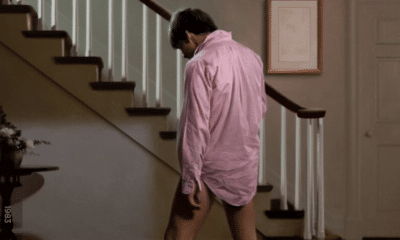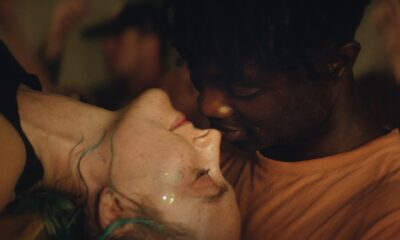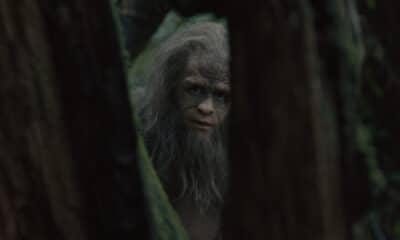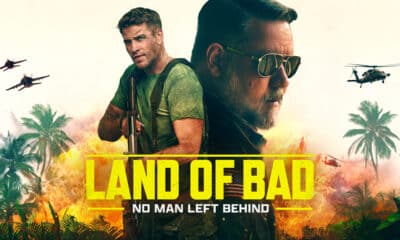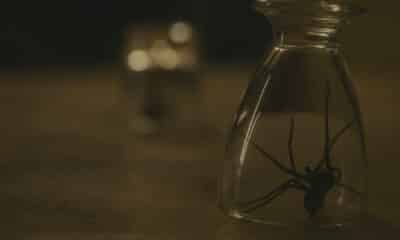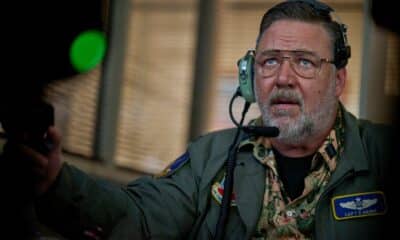Debuting at last summer’s virtual Fantasia event, Come True instantly became this writer’s favourite film of 2020. Blending elements of horror, sci-fi, drama, and even romance, the film was utterly and uniquely original. The narrative is complex, but essentially tells the story of Sarah (Julia Sarah Stone), a young woman plagued by bad dreams, as she signs up to participate in a sleep study. The study however, accidentally awakens something, something bad, something that is trying to claw its way into her consciousness. Directed, amongst many other roles, by Anthony Scott Burns, Come True is an unholy union of neon-drenched visuals and a pulsating synthesised score that lingers in your mind long after watching.
Ever since that initial viewing at Fantasia, Come True has been a film that I have often revisited in my mind. It’s the type of film that truly digs under the skin, and with standout music from Electric Youth (who performed on the Drive soundtrack) who directly collaborated with Anthony himself, (under his musical moniker of PilotPriest) induces an almost trancelike state. It comes as fantastic news then that Lightbulb Distribution have picked up the film for the UK, and it will arrive into our home digitally on Monday 15th March, with a limited edition blu-ray to follow on Monday 5th April.
Ahead of the release, I caught up with Anthony to probe deeper into this slice of science-fiction perfection.
What inspired you to create a film around dreams?
I had seen an article by Berkeley, it was an educational journal, and they released video footage of something they were developing where they take brainwaves and translate brainwaves directly without any sort of imaging device, and take what someone was seeing and make video out of it. I was really intrigued about that because I thought if there’s no lensing or anything, and it’s just brainwaves, why couldn’t we take the same information when we’re sleeping, and make something so that we can see dreams.
I had seen the documentary The Nightmare by Rodney Ascher, which is a great documentary. It unlocked something in me where I remembered that I had had sleep paralysis when I was a kid. I had forgotten completely about it. My mother passed away when I was eight years old, and I had this horrific thing where I thought my mother had come back as a ghost and was sitting at the end of my bed, but I couldn’t move. I would wake up and see this shadowy figure at the end of my bed and I was just horrified and filled with grief. Slowly I started to get scared of this thing because I realised it wasn’t my mother. If it was my mom, she would turn around and speak to me. Then it got to the point where I knew that if it turned around, it would kill me. I got really scared every night, and then it just went away as quick as it came. But when I watched the documentary, I realised I wasn’t alone in my vision of ‘it’. That visually ‘it’ looked the same as how people were describing. That was really wild to me because this is pre-internet. There weren’t a lot of jpegs and gifs popping up with this image that might influence you to see it. So where did I see it? Where did it come from? Why was I seeing the same thing as these other people and that really intrigued me. So the combination of those two things was the impotence. This is a shared experience, and I had weirdly been reading a lot of Carl Jung, and this idea of the collective consciousness, something that we all share without even talking about it, just supported his theories. It was a no-brainer that I would take all that stuff that we all share, and make it into something interesting and horrific.

Outside of film, you’re a musician. Come True is the perfect marriage of haunting score and stunning visuals, when conceptualising the idea, what came first, images or sounds?
I think the sound comes first on all my projects. I tend to write themes, and in this case I had been talking with Electric Youth for about six years. Come True was supposed to be my first film. For whatever reason at the time, my representation just thought it was too bizarre and weird, but I wanted to make it as my first film so that people would know that I wanted to make these kinds of movies. They [Electric Youth] had written a piece of music that I really loved, and I had done two remixes for them that I actually held onto for many, many years to put them in the film. Those two things sort of just became the sonic landscape and we both developed themes from there, and so the music was always around. We shared it with the actors, and the actors even came up with playlists that they thought would work for their characters, so music was a huge part of it.
I can’t escape my marriage that way to the images, because it’s weird, I feel like and this kind of underplays everybody else’s involvement in the film, but I think that music is eighty percent of a film. Maybe not all films, but definitely some, and definitely my films. The reason is if you re-score them with something else…you could break pretty much every great film that we love with a bad score. I think that’s true. You could break it and it wouldn’t be the same movie and it wouldn’t feel the same way. Sound is really important to me. I would say that Come True is kind of like a music video; that will be annoying to some people, but it’s a music video of a different kind.
The song Modern Fears just lives in my head now, it’s just there forever.
So how they delivered that to me, is I got the stems of the vocals and all the stuff, and I like to do remixes from the beginning. Just take as little as I can and just work from that. I wanted to create something, I don’t know if this came across to you, but something that had the vibe of Labyrinth if that makes sense. Bowie often has a darkness underpinning his pop melodies and I really wanted to challenge myself to do something like that with the music. Take that pop sensibility and add that layer of darkness.

The other big element of the film are the nightmare sequences which are genuinely horrific. I remember watching them and feeling instantly uncomfortable with how the figures looked and moved, how the camera was constantly pushing forwards, replicating that dreaming sensation where you can’t control what is happening. It really tapped into those subconscious fears, did you do much research into the phenomena of nightmares?
Yeah we did a lot of research. Even in the development of how the dreams look. We thought about early on, “can we film these?” I had realised that most of the films that I loved, even when they went into this dream realm, you could always tell that it was filmed and that took you away from the otherworld uncanny thing that happens in dreams. You can never really replicate it. So we decided to go full CG. We spent a lot of time trying to create the perfect movement, the perfect lighting, create the perfect dimensions so that things feel unnatural. I’m sorry that it made you feel weird, but that was the goal. To not be scary in a way that I had seen before, in a way that again worked to the themes of the film. These are primal fears and we don’t understand them. I tell people when I wrote the movie and when I came up with the dream sequences, I really ran on the subconscious and, “hey I’d like to do this cool thing or that would be cool”, it ran on a feeling. If the feeling was right and it felt like a dream, then it was allowed to be in the film.
You did so many of the production roles yourself – writing, directing, composing, the cinematography, VFX – what are the benefits for being such a hands-on filmmaker?
I tell people I wish I had the kinds of budgets that David Fincher has, because then I wouldn’t have to do all of those jobs. But the reality is that the market has changed, and I guess the benefits. I wouldn’t know because this is the way I make films. I wouldn’t know the benefits versus the loss that I get. But I do know that I can’t afford the craft people that I wish to have on my sets. I just can’t. Especially because I value time with actors. Modern films, we tend to get, even regular budgeted theatrical release films, you tend to get about thirty days to shoot your movies now. To me that just isn’t enough to enjoy the process and to be with the actors and work with them in a way that is exciting. All the movies I grew up loving had a hundred days to shoot or more. To really slash that into a third, it doesn’t make any sense to me. I like doing takes because you can unlock magic. If you don’t have time to unlock magic, you’re just on a speeding train. What me doing all the jobs does is afford us that time on set. While I wish I could have the collaborators, we just can’t afford them right now, and I don’t know at what point I will be able to afford them.
I’ve personally been a fan of Julia Sarah Stone since I saw her in The Unseen, when did you stumble upon her and what qualities do you think she brought to Sarah?
I had seen her in AMC’s The Killing. I was watching that series and I was taken by many members of that cas; that cast was just great overall, so the casting director on that show really did my job for me. It was a couple of years later when we were doing casting that I saw her name there and without even reading her or anything, she didn’t audition, I just sent her the script and said “how does this feel to you?” She really responded to it. She’s told people she read it in one sitting, and then she wanted to play that character because it was a different character to what she had done before. The process was, I tried to bring people onboard that really wanted to do this kind of movie, and really enjoyed the script.
She can emote like nothing I’ve ever seen before. This film needed it because I’m somebody who, like it or hate it, I like to tell my stories as much without dialogue as possible. With just people’s emotions and their faces. I think it’s just much stronger. It’s a personal preference, but I need actors who can carry the movie with just a look and Julia can do that.
And I mean she’s one Hell of a trooper, there’s those night scenes where she’s essentially just in nightclothes…
Because we are a low-budget production, we did everything we could to help her. I found these little things you could put on the bottom of your feet that are invisible. Like invisible stick-on’s so when you’re walking barefoot you don’t have to touch the ground. We really went out of our way to make it as comfortable for her as possible. It was cold. It was freezing cold. We had thermal stuff hidden underneath the gown, but it was never enough so she really was a trooper. Also, she’s essentially a puppet at that moment so the acting “Julia, walk from here to here” so she really was a trooper. But it was fun. We had a lot of fun on that set. It’s another thing for us when we’re making these movies…I’ve been on too many sets whether as a VFX artist or whatever where I just saw the crew and the director being pushed and it was stressful. Everyone was at each other’s throats. I just didn’t want to do that. So we tried to devise a way of making movies that was fun and felt like the first time you got into film school, or on a student film, or your own independent film. I just wanted to keep that feeling of youthfulness.
I spoke to Landon and Julia last year and they were both particularly pleased that they got to experience the Northern Lights while they were filming, so I don’t think they were too put off by the night shoots.
It was beautiful. That’s the thing, on a regular set you just don’t have time for that. We just took a moment out there, this small crew, there were just five people plus the actors and we just stopped and we’d go check it out and then go back to work. I think that’s how I want to keep doing things this way.
The mixture of high and low-fi tech really creates that feeling of timelessness. Where did you source all of the tech?
Ebay. Ebay was a friend of ours during that period. Essentially I would just search for shells of things that I thought would be interesting. Some of the old tech is old kids toys from the seventies. We would kit bash things together like they did in the old days. My father used to work in the film industry when I was a kid, and he made a lot of props and things like that, so I saw how they were put together quite easily out of garbage essentially. You could make something cool and I wanted to bring that back. So yeah, a lot of stuff on eBay, a lot of spray paint’ I even got a 3D printer to do some custom buttons and things like that. It was me and my producer Nick [Bechard] just spray painting and gluing things together.

It really works though. So many sci-fi films go too far into futuristic tech and after a couple of years later they already feel dated. Here by mixing all these different textures and styles it just feels more grounded in a strange way.
It harkens back to when we were children too. You pick up something in the kitchen and all of a sudden it’s a drum or whatever it is to you through your mind’s eye. The child’s minds eye sees something different. Whether it’s Luke Skywalker’s Lightsaber, which is also a flashbulb, I just love this idea of taking something that exists and turning it into something else. Some of the stuff was really hard to find because I wanted certain kinds of monitors, which are really hard to find and source nowadays. But it was all worth it and I’m glad that you enjoyed it because it wasn’t done for no reason as well. It really is about having a familiar yet off environment. The whole movie is familiar, yet alien, and I think that’s its strength, and that’s what we’re going for. The familiarity to draw you in, but then there’s something wrong. That’s what dreams are. They tease you with what you know, and then they introduce bizarro stuff that gets under your skin.
With such a blend of genres, range of themes and ideas explored, what do you hope people will experience when watching Come True?
I hope they surrender to it, and allow themselves to not be marred by the idea that a) a movie needs to be perfect, b) be a plot that is easily followed, and I hope on the other side I hope it feels like they had a dream. That maybe there is a way for us to blur the line of this collective consciousness in a cinematic way.
It certainly had that effect on me personally. I really connected with the film.
You wanna make a movie that’s not for everybody so that when it is for someone it’s really for them. This idea of making things for everybody, I think it dilutes the power of movies that aren’t for everybody. I think those are the kinds of movies that we all gravitate towards now in hindsight were the films that weren’t for everybody at the time. I’m glad it really connected with you because you are who it is for.

I’m a massive Terminator nerd and Come True just felt a lot like it. I mean there’s the poster in the background of a scene – we’re clearly on some kind of similar wavelength.
The nightclub film is only put into the film because I wanted to have a nightclub scene to pay a sort of homage. I mean, look at the lighting throughout the film. The lighting is supremely influenced by The Terminator. It’s because the statement there was that no one makes movies as ambitious as The Terminator anymore, because we’re not allowed. This was me saying, “no, we’re going to do this.” Even though most of our films are on the budget range that we were within, it’s about one person in a room. That’s all you can afford on the budget we were working with. I didn’t want to make any more horror movies about one person in a room, or two people in total. I wanted ambition and the bigger world. I think maybe that’s what you connected to as well. The idea that we’re trying to make something ambitious and fresh, and just like The Terminator. So while they’re not the same kind of movie, they are in their DNA.
There must be something to that, I love The Terminator, it’s a comfort film, and Come True gave me that same feeling on an unconscious level.
Well yeah. The character of Jeremy wears a trenchcoat for a reason…
And she’s called Sarah…
There’s many, many, many things. That’s also fun for people to watch the film and pick those things out. Again, it goes back to dreams. When you’re in a dream, there are these little moments here and there that you recognise, and that’s what we wanted to layer in. It’s a cinematic dream.
You’ve spent so many years on this project, have you had a chance to think about what you might want to do next?
Yeah, I’m working on two new scripts now and I’ve been holding off – the dream was to be shooting now – but I think thanks to Covid, I don’t feel like the world needs more movies, as much as we need to be safe. Even though we have small crews I just don’t think it’s worth putting ourselves at risk right now. I’m just going to wait until we’re ready and safe to go and we’ll go make another movie. There are multiple projects just waiting for us to shoot them, so that’s good.
Come True will be available on Digital HD on Monday 15th March, with a limited edition Blu-ray released on Monday 5th April 2021.
Kat Hughes is a UK born film critic and interviewer who has a passion for horror films. An editor for THN, Kat is also a Rotten Tomatoes Approved Critic. She has bylines with Ghouls Magazine, Arrow Video, Film Stories, Certified Forgotten and FILMHOUNDS and has had essays published in home entertainment releases by Vinegar Syndrome and Second Sight. When not writing about horror, Kat hosts micro podcast Movies with Mummy along with her five-year-old daughter.

Latest Posts
-


Home Entertainment
/ 5 hours ago‘Risky Business’ and ‘Blow Out’ are getting the UK Criterion treatment
Risky Business and Blow Out will be released on UK Criterion 4K Blu-ray this...
By Paul Heath -


Film News
/ 5 hours agoRelease date announced for ‘The Outrun’ with Saoirse Ronan
After premiering at this year’s Sundance and the Berlinale in Germany, the UK release...
By Paul Heath -


Apple TV
/ 1 day agoTrailer: André Holland leads Apple’s new limited series, ‘The Big Cigar’
Apple TV+ has released the full trailer for The Big Cigar, a new, six-episode...
By Paul Heath -


Film News
/ 1 day agoUK trailer, poster and release date for Sundance smash ‘Sasquatch Sunset’
Premiering in the UK at the Sundance London event in June is the brilliant...
By Paul Heath
